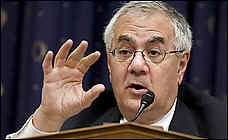 |
Daily Blog - Tiger Software People have asked me to
write a Daily Blog. They seem to want |
Thursday
- June 28, 2007 - Who's Guarding The Investors' Hen
House?
New SEC Chairman Cox and Investor Protection
The issue of a toothless, for show only, Securities and Exchange
Commission will
not go away. On the one hand, Wall Street's crooks
are always busy finding new ways
to rig stocks and fleece investors. On the other hand, the
SEC is charged with protecting
investors and keeping the playing field fair. But it's an
uneven battle. Those on the inside have all
the advantages, especially if the SEC is understaffed and lacks
the will and muscle to
protect investors. I have focused www.tigersoftware.com on this imbalance. I always
come back to the notion that investors have to look affter their
own interests. And one of
the very best is to use Tiger Software's Accumulation Index and also Joe Granville's OBV
Line. Let the market tell its own story. We can
usually spot insider selling, long before it is reported.
I read with
interest how the new SEC Chairman's style and priorities are becoming
clear after being appointed a year ago. When his
appointment was announced, the LA Times
ran an article by Michael Hiltzik on June 9, 2005 with the
headline
Cox's Past Ties to Con Man Raise Questions
"In
the halls of Congress, Rep. Christopher Cox (R-Newport Beach), who has just been
nominated to be the nation's top securities
regulator, stands out for his intelligence.
"When
it comes to the work he performed as a lawyer for one of the state's most notorious
con men, however, he pleads ignorance. Apparently he
was unaware that William E. Cooper
was a crook or that his company, First Pension Corp., was a
fraud. In 1985, when Cox assured
state securities regulators that a new Cooper investment
scheme would be "low risk" and an absolute
boon to small investors trying to save for retirement, he
was apparently unaware that the scheme
was really designed to hide the losses already incurred by
Cooper's investors and to keep the scam
alive. In 1991, when Cooper hosted a fundraiser for Cox at his
Villa Park home, Cox thought of him
as merely "an upstanding member of the community.
"A few years after
that, the fraud finally exposed, Cooper and two partners went to jail. And now,
Cox has been nominated by President Bush as chairman of the
Securities and Exchange Commission."
Back in 1995, as a
Congressman, Christopher Cox had authored a bill which became the
Private Securities Litigation Reform Act of 1995. This changed the
long-standing Securities Exchange Act
of 1934. It required a plaintiff to identify in his
complaint each Insider statement which is alleged to have
been misleading. Seems reasonable.
Most important, Cox's legislation required the shareholder-plaintiff to prove that the
Insider knew
the challenged statement was false at the time. This
is important because shareholders often do not
have access to proof of what the state of mind was of the
Insider. Again quoting from wikopedia.com,
"This requirement allows defendants to obtain dismissal of
cases where the plaintiff merely points to a
false statement and declares that the defendant "must have
known" that the statement was false,
based upon his position within the company. This requirement has frequently proven difficult for
plaintiffs
to overcome because, without the benefit of discovery, plaintiffs
often do not have access to witnesses or
documents that might prove the defendant's state of mind in
making the false statement." Critics called
this piece of legislation, the "Ken Lay Protection
Act".
Background: The 1934 Securities legislation:
(quoting
now from wikepdia.com) "gives shareholders the right to bring a private action in
federal
court to recover damages the shareholder sustained as a result of securities fraud.
To
make a such case against an insider, the Supreme Court as ruled that the:
1.
The defendant made a "material misrepresentation or
omission";
2.
The defendant intended to make the material misrepresentation/omission,
or
acted with recklessness in making the misrepresentation/omission);
3.
The material misrepresentation/omission was made "in connection
with the purchase or
sale
of a security";
4.
The plaintiff who was allegedly victimized by the fraud relied upon the
material
misrepresentation/omission.
5.
The plaintiff suffered an economic loss as a result of the alleged fraud; and
6.
The plaintiff can allege and prove "loss causation," which means
that the allegedly
fraudulent
misrepresentation or omission caused the plaintiff's economic loss.
See
Dura Pharmaceuticals, Inc. v.
Broudo, 544 U.S. 336 (2005).
Yesterday,
CNN reported that the new SEC Chairman had appeared before the House of
Representative's Financial Services
Committee, chaired by Massachusetts Barney Frank
 To the surprise of his critics, the hearing was not heated
To the surprise of his critics, the hearing was not heated
or contentious. But what did emerge
was that the SEC had voted to support investors in a
Supreme Court case that could determine
liability for Enron's "secondary actors," but after
talking to President Bush, Cox
discouraged the SEC and the Solicitor General from acting
as a "friend of the court"
(amicus curiae) and siding with the investors. President Bush stated
it would be better for business and the
economy if the SEC regulated insiders, rather than
letting independent lawyers do it through
investors' law suits.
(http://www.cfo.com/article.cfm/9333431?f=related&x=1
)
The
SEC has sued " secondary actors for helping Enron to misrepresent its financial
health
before its collapse in 2001.
As of February, 2007, the SEC has collected $440 million from
settlements and enforcement actions
against individuals and business partners (including some
banks) that it accused of
participating in Enron's fraudulent activities. The SEC
has not yet
announced a distribution plan for the
funds!. (Sarah Johnson, www.cfo.com - June 13,
2007).
See http://www.washingtonpost.com/wp-dyn/content/article/2007/06/13/AR2007061302124.html